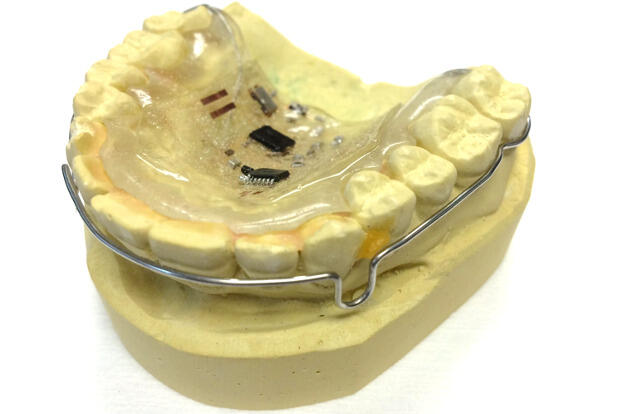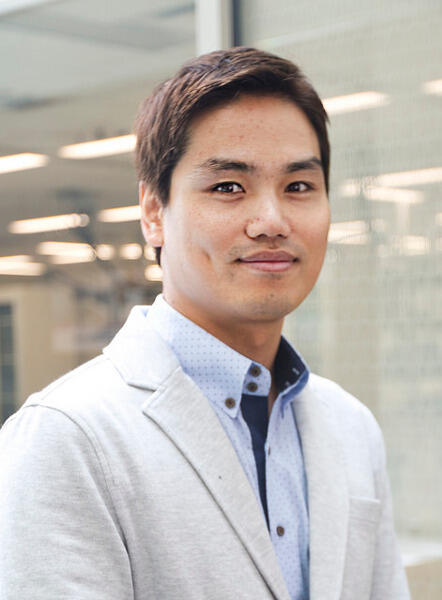
Jan. 7, 2016
Tasting device monitors sodium intake in hypertension patients
Share this story
Our sense of taste ties directly to our overall health. It helps us know when food has gone bad, when it will not agree with us, or when it simply is not good for us, such as when something is too salty or too sweet. For the aging population, the sense of taste slowly deteriorates over time, so managing diet becomes increasingly tricky.
To help people who have lost their sense of taste or have difficulty monitoring what they eat, a team of researchers at Virginia Commonwealth University is working on an artificial taste-sensing system. The design will both monitor and manage the user’s diet and also potentially help modify eating behaviors.
“The first app is something simple,” said Richard Costanzo, Ph.D., professor of physiology and biophysics and director of research in the Department of Otolaryngology in the School of Medicine. “Like, why not set up a detection system for something like salt, which is pretty easy to detect and may help people with hypertension.”
We miniaturize everything. Microscopes are our friends.
Costanzo is an expert in taste and smell, and first conceived this idea for an artificial taste-sensing system that goes inside the mouth a few years ago. His original design was a tooth with a miniaturized sensor that fits like a filling. Since then, he has brought in collaborators to bring his idea to life, including Woon-Hong Yeo, Ph.D., assistant professor in the Department of Mechanical and Nuclear Engineering in the School of Engineering.
Yeo specializes in flexible electronics and low-profile biosensors and has been developing the exact kind of nanotechnology-driven electronics needed for Costanzo’s idea.
Instead of large electrodes, a tangle of wires and bulky control stations for health monitoring, Yeo works in the miniature. He designs nano-tattoos — small, ultralight, wearable monitoring devices that feel like a second skin and move with the human body. “We miniaturize everything,” he said. “Microscopes are our friends.”

Yeo and Costanzo received funding from the MEDARVA Research Foundation in Richmond to develop a sodium-sensing system in the oral cavity. Instead of the tooth mount of Costanzo’s first design, this device is designed to be worn inside the mouth, mounted on an orthodontic retainer created by James Coffey, D.D.S., associate professor of prosthodontics in the VCU School of Dentistry.
Think of it as a Fitbit for the mouth. In the case of the Fitbit, the technology measures acceleration and translates that information into data such as distance, steps and calories burned. It also will encourage you to move if you’ve been idle too long.
For the sodium-sensing device, the technology measures the concentration of sodium ions coming in through the mouth and transmits the data to a smartphone or other monitoring system. Once the sodium threshold is reached for the day, the user is alerted.

So if an elderly woman with hypertension is eating potato chips (while wearing the taste-sensing retainer), and she reaches her sodium maximum for the day, she will get an alert so she knows to stop eating sodium.
“This is a serious problem, hypertension — diabetes is another problem but that’s more sugar related — and right now there are no devices out there that are bionically monitoring this information, feeding back this information, or beeping and saying, ‘Hey, you’ve had enough,’” Costanzo said.
He believes it could also teach people to modify their eating behavior in the way that other biofeedback apps do, again like the Fitbit.
The app with feedback alert system is being developed through a collaboration with Wei Cheng, Ph.D., assistant professor of computer science in the VCU School of Engineering, and the Websmith Group in Richmond.
Design in miniature
The sodium-sensing system starts with a microcircuit pattern that Yeo designed on the computer with illustration software. There are then more than 50 steps in the microfabrication process that took Yeo a year to devise.
The final sensor consists of a copper membrane circuit that’s 200 nanometers thick (that’s 100 times thinner than a strand of human hair), a data-processing chip that converts the analog data from the sensors into digital data, and a Bluetooth chip that transmits the digital data to a wireless receiver or smartphone.
All of it fits onto a thin piece of flexible elastomer slightly thicker than a Band-Aid measuring about 2 by 1 inches. “The advantage is that it can be bendable and stretchable without fracturing the material so we can put it on pretty much any surface,” Yeo said. He’ll work with the retainer mount for now, but he mentions the possibility of the sensor simply being glued to the roof of the mouth.
Yeo will eventually expand the taste sensor to include the other four tastes: sour, sweet, bitter and umami. “I’m working on the sodium sensor and trying to add a pH sensor for sour, and the three other tastes will come later,” Yeo said. “Umami is the hardest.”
Eventually, Costanzo and Yeo want to connect their sensor with the body. Much like a cochlear implant stimulates cochlear nerves to help a deaf person hear again, an internal taste implant would receive data from the food molecules coming in and then stimulate the appropriate nerves to create a perception of that taste.
“We’re approaching an era in the next couple decades where we will be interfacing with the brain and our perceptions with electronic devices,” Costanzo said. “Maybe we can even trick our brains into liking broccoli.”
Maybe we can even trick our brains into liking broccoli.
Subscribe to the weekly VCU News email newsletter at http://newsletter.news.vcu.edu/ and receive a selection of stories, videos, photos, news clips and event listings in your inbox every Thursday.
Subscribe to VCU News
Subscribe to VCU News at newsletter.vcu.edu and receive a selection of stories, videos, photos, news clips and event listings in your inbox.









